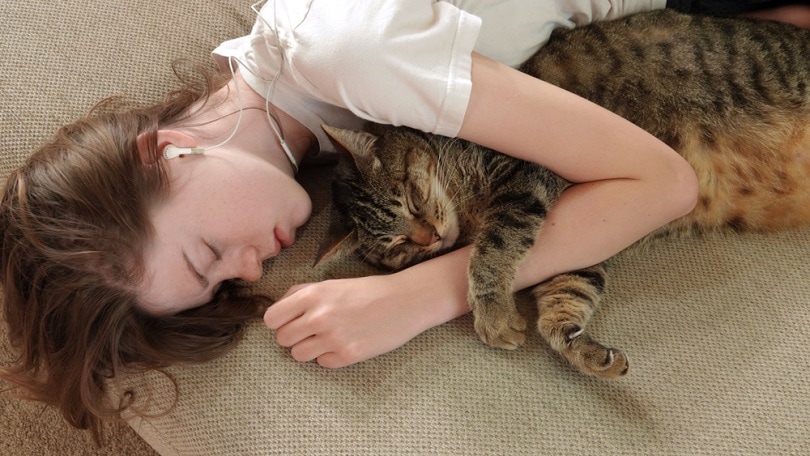Click to Skip Ahead
We all love to spoil our cats, so they tend to get new toys and tasty treats more often than we do! Seeing them napping in odd spots around the house inspires many cat owners to purchase a special cat bed for their favorite feline, in the hopes that it’ll be their new favorite sleeping spot.
But what often happens is that after you purchase the bed, you bring it home, set it up, and wait expectantly. Your cat takes a few moments to explore the new piece of furniture and even climbs in and circles a few times. Then, they turn tail, hop onto your lap, and settle there instead.
Nobody can turn down cuddles with a pet, especially when they’re willingly offered. However, with a brand-new, cozy cat bed being ignored, you may wonder why your cat prefers to sleep on you instead.
Fortunately, your cat isn’t doing it to spite your recent purchase. They have well-meaning intentions when they lie on you!
The 5 Reasons Why Cats Lie on You
1. Attention Seeking
It can be awkward to be in the middle of working at the computer when you find yourself acting as a chair for your cat. But it’s their way of telling you that they would like attention. Since they can’t speak the same way that we can, cats have to rely on their body language and actions to get their point across.
Your lap isn’t just a comfy place to sleep; it’s also the best spot for getting petted. Even if you are writing an important email or are on a video call, if you have a cat lying on you, you likely start automatically running your fingers through their fur. The best part is that their rumbling purrs aren’t only soothing to them, but they can also soothe your nerves or work-related stress.

2. Bonding
Cats might seem naturally standoffish but they can be surprisingly social. Sleeping with family members, whether feline, human, or even canine, also serves as a bonding exercise.
You may find that your cat doesn’t just take a nap on your lap. They might sit and wash their face or clean their paws before settling down. Sometimes, they will lick your fingers or hand as you pet them.
Grooming is a way that cats bond with their loved ones, and lying on you is the same thing. Your cat wants to show affection by being as close to you as possible.
3. Security
We all like to feel safe when we’re sleeping, and lying on you is a sign that your cat trusts you to keep them safe while they’re napping.
There’s safety in numbers, and domestic cats are both predator and prey animals. This means they take measures to keep themselves safe from other creatures that might harm them.
Most of their behavior is learned as a kitten, when they cuddle up to their litter mates and mother. This gives them a secure spot to sleep and helps them stay warm and develop necessary social skills for later in life.

4. Territory
Marking territory is an important habit for your cat. While the prospect of belonging to a cat might seem strange to some people, it’s actually a high compliment. After all, cats wouldn’t mark you with their scent if they didn’t like you.
Sitting on your lap might be a less obvious claim than rubbing against your leg, but it works the same way. The more often your cat lies on you, the more their scent settles into your clothes and on your hands when you pet them.
In this case, taking a nap on you is a bit like multitasking. Your cat can benefit from a recharging nap and can tell the dog that you have a favorite pet and it’s not them.
5. Warmth
If you’ve had cats for a while, you might have noticed that there are certain times when they’re more likely to lie on you. Cats like to be warm, so they may want to take advantage of your body heat.
While they might not lie on you as often during summer, you’ll often find that the colder months are filled with cuddles from your cat. They’ll also be more likely to gravitate toward the warmer parts of your body, like your chest while you’re sleeping or your lap if you’re watching TV.

Should You Let Your Cat Sleep With You?
Whether you let your cat sleep with you depends on your preferences and if they interrupt your sleep. There isn’t a right or wrong answer here, though there are a few factors to consider if you’re wondering whether you should get your cat their own bed.
Allergies
If you or your partner have a cat allergy, it’s best if you don’t let your cat in the bedroom with you. Keeping at least one room in your house cat-free gives you a place to take a break from any allergic reactions caused by your cat. It also enables you to sleep easily without being bothered by your allergies.

Children and Babies
Children and cats can both be cuddle bugs. They love to snuggle, whether they’re awake or asleep. If your child is under 5 years old, though, or a baby, it’s not a good idea to leave them unattended with a cat.
While you can push a cat off your chest if they get too heavy, younger children might find it more difficult. It’s also possible for a napping kitty to accidentally suffocate a baby.
Children might inadvertently hurt your cat if they get too excitable around naptime or aggressive with their cuddling. They might not intend to upset your cat, but they might end up with a frustrated or skittish animal scratching at them to get away.
Habit
The habits that your cat develops as a kitten can follow them for the rest of their lives, even simple things like curling up on the bed to sleep. Provided that you’re fine with an adult cat cuddling up with you on the bed while you sleep, there’s nothing wrong with encouraging this behavior in your new kitten.
Bear in mind that an adult cat is much bigger and heftier than a tiny kitten and might interrupt your sleep more.
Kittens
The age of your cat plays a part in all this too. While adult cats aren’t likely to be squashed if you roll over, a tiny kitten barely weighs anything at all. You can easily dislodge them from their perch on your chest and accidentally trap them under your arm or body if you fidget too much during the night.
Multiple Cats
More cats mean more cuddles but there is a downside. The more cats you have, the heavier they’ll be. If they’re all pressed against you during the night, you might be super warm and toasty, but you’re also likely to end up sleeping in an uncomfortable position. While cat cuddles can be worth the aches of stiff muscles, sometimes it’s better to sleep well.

Relaxation
Purring is one of the best things about owning a cat. The soft rumbling noises that they make when they’re settling down to sleep can help ease your mind too.
If you’ve had a bad day, a purring cat curling up on the blankets with you is a surefire way to relax and get much-needed shut-eye.
Warmth
Your cat isn’t the only one that benefits from your body heat. You can take advantage of their presence on your bed too, especially if it’s a cold night where you just can’t get warm. Having your cat curled up against your side might pin you in an uncomfortable position, but you’ll be nice and cozy.
Conclusion
Whatever the reason that your cat has designated you as their chair, take the time to appreciate their presence. While they might be after attention or just seeking a warm spot to nap, they trust you to provide the solution to both needs. As a bonus, your cat shares their warmth and relaxing purring with you while they’re cuddled up close. It’s a win-win.
Featured Image Credit: Impact Photography, Shutterstock













